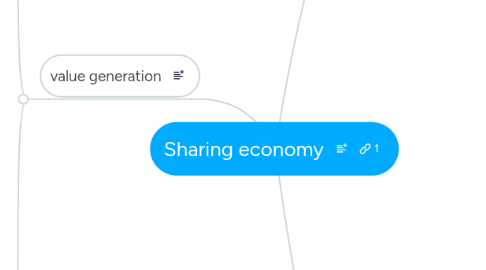
1. value generation
1.1. item creation
1.1.1. open (crowdsourcing)
1.1.1.1. collaborative
1.1.1.1.1. license free IT platforms
1.1.1.1.2. license free content
1.1.1.1.3. comment on license free content
1.1.1.1.4. recommendation on license free content
1.1.1.2. competitive
1.1.1.2.1. comment on propietary content
1.1.1.2.2. recommendation on propietary content
1.1.1.2.3. propietary content
1.1.2. closed
1.1.2.1. collaborative
1.1.2.1.1. bicycles for shared urban systems
1.1.2.1.2. public transportation vehicles
1.1.2.1.3. public information items
1.1.2.2. competitive
1.1.2.2.1. UBER self driving cars
1.1.2.2.2. traditional hotel rooms
1.1.2.2.3. airplanes, taxi's and other private transportation vehicles
1.1.2.2.4. internal wikis
1.1.2.2.5. AIRBNB starts building hotels
1.1.2.2.6. propietary IT platform
1.2. item sharing
1.2.1. collaborative
1.2.1.1. public rental/sharing services
1.2.1.1.1. public bicycle systems
1.2.1.1.2. school system
1.2.1.1.3. health system
1.2.1.1.4. public infrastructures
1.2.1.1.5. public transportation
1.2.1.1.6. public libraries
1.2.1.2. public matchmaking services
1.2.1.2.1. unemployment offices
1.2.2. competitive
1.2.2.1. private rental services
1.2.2.1.1. car rental
1.2.2.1.2. community laundries
1.2.2.1.3. taxi service
1.2.2.1.4. bike rental
1.2.2.1.5. house rental
1.2.2.2. private matchmaking services
1.2.2.2.1. home sharing
1.2.2.2.2. car sharing
1.2.2.2.3. life sharing
1.2.2.2.4. travel sharing
1.2.2.2.5. information sharing
1.2.2.2.6. food sharing
1.2.2.2.7. transportation sharing
2. benefits for service
2.1. intangibles
2.1.1. end user
2.1.1.1. affordability
2.1.1.2. convenience
2.1.1.3. freedom from status
2.1.1.4. maintenance free
2.1.1.5. networking
2.1.2. end service provider
2.1.2.1. reputation
2.1.2.2. recognition
2.1.3. intermediary
2.1.3.1. reputation
2.1.3.2. visibility/recognition
2.1.4. community
2.1.4.1. better relationships
2.1.4.2. more sustainable environment
2.2. tangibles
2.2.1. end user
2.2.1.1. savings
2.2.2. end service provider
2.2.2.1. service fees
2.2.2.2. tips
2.2.3. intermediary
2.2.3.1. service fees
2.2.3.2. intelligence
2.2.3.2.1. sales of intelligence
2.2.3.2.2. system improvements
2.2.4. community
2.2.4.1. taxes
2.2.4.2. crowdfunding
3. cost of service
3.1. intangibles
3.1.1. end user
3.1.1.1. social risk
3.1.1.2. poor service
3.1.1.3. information fatigue
3.1.2. end service provider
3.1.2.1. social risk
3.1.2.2. stress
3.1.2.3. damage to reputation
3.1.3. intermediary and/or community
3.1.3.1. damage to reputation
3.2. tangibles
3.2.1. end user
3.2.1.1. subscription or fee
3.2.1.2. access device(s)
3.2.2. end service provider
3.2.2.1. item maintenance
3.2.2.1.1. tear & wear
3.2.2.1.2. damages
3.2.2.2. insurance
3.2.2.3. operating costs
3.2.2.3.1. gasoline
3.2.2.3.2. utilities
3.2.3. intermediary and/or community
3.2.3.1. system personalization
3.2.3.2. system maintenance
3.2.3.3. community management
3.2.3.4. infrastructure
3.2.3.5. shared item production
